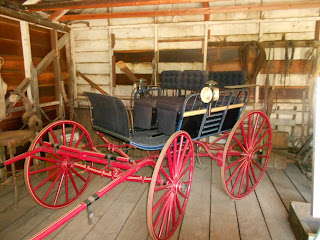 |
| Late 1800's Carriage |
The subject of the Frontier America is one of our country's biggest stories. In a large way it was all about Manifest Destiny, the U.S. self given mandate to occupy North America from the Atlantic Ocean to the Pacific.
One of the best ways to learn about life during the days of western settlement is to visit some of the smaller museums spread throughout the western states. They make an excellent as well as economical addition to your western road trip planner. Many of these smaller museums are free to browse in. Most are operated by historical societies. Visitors can donate whatever amount they wish. At other museums the fees are nominal. These museums are also terrific side trips for the entire family. And are filled with historic artifacts and photos.
Frontier America involves all kinds of history. The Oregon Trail, the Indian Wars, the gold mining booms, the Mexican American War, stagecoaches and railroads and the building out of towns and cities that were at one time merely camps. It's a fascinating subject and the artifacts, photos and exhibits at small town museums do a great job in telling the story. You’ll also find well informed docents who can answer just about any of your questions.
 |
| Enlistedmens Barracks, Fort Stockton Texas |
More photos and information about Fort Stockton is in our Western Trips article about the historic west Texas fort.
Another site in Fort Stockton you’ll want to add to your trip planner is the Annie Riggs House. The Annie Riggs House was a frontier hotel with quite a lot of history. A tour of the Annie Riggs House features period artifacts along with fully furnished rooms. It’s definitely worth the stop while in Fort Stockton.
 |
| Red River Museum, Vernon Texas |
The Red River Valley Museum does an excellent job in telling the story of the frontier cattle days in Texas. Another interesting thing about the museum and Vernon Texas is that it was on the old Texas Trail which started on the Rio Grande in south Texas and eventually extended with additional routes that led all the north to the Canadian border. Various parts of the Texas Trail went by different names, especially in the northern sections. The Texas Trail sometimes referred to as the Great Texas Trail was the longest of any of the old cattle trails. Just a few miles northeast of Vernon is a place called Doan’s Crossing. Doan’s Crossing is on the Red River which in the 1800’s was the Texas border with the Indian Territory, now present day Oklahoma. Doans's Crossing represents the spot where the Texas Trail cowboys drove their herds across the river and into Indiahttp://westerntrips.blogspot.com/2014/08/visit-truckee-california-and-its.htmln Territory on their way to the Dodge City Kansas rail heads.
See our Western Trips article and photos of the Red River Museum in Vernon Texas and a Visit to Truckee CA and It's Historic Hotel
 |
| Old Navajo County Jail exhibit |
There is a section of the building which was the old sheriff’s office and jail. The jail you will see is one of the oldest jail exhibits in the west and was constructed in the east and shipped to Holbrook by rail.
See our photos and history in our Western Trips article about the Navajo County Holbrook Courthouse Museum.
 |
| Charles Bent House and Museum |
Charles Bent House- The Charles Bent House is located in Taos New Mexico, about an hour and a half drive north of Santa Fe. Charles Bent was the very governor of the New Mexico Territory. The New Mexico Territory was created after the Mexican American War in the latter part of the 1840’s. The territory was ceded to the U.S. from Mexico as part of the peace agreement. The Mexican government only controlled New Mexico for about twenty years after they expelled the Spaniards from North America in the 1820’s. The first years of territorial government were rugged times in New Mexico in as much as there were so many diverse cultures there. The territory was essentially Spanish and Mexican with a large population of Native Americans. Loyalties at first were all over the place. The Indians always had a mixed relationship with the Spaniards and later Mexicans and the introduction of American rule just added to the diversity of interests.
You’ll be interested in our photos and article of the Charles Bent House Museum.
Unfortunately for New Mexico Territory’s first governor, there were plenty of hostilities to go around. Governor Charles Bent was killed in a massacre at his home in Taos in 1847. There are a few versions of what exactly occurred but the prevailing story is that a group of disgruntled Mexican soldiers along with some northern pueblo Indians made an attempt to oust the Anglos from New Mexico. Charles Bent was shot when standing in the doorway of his home and died soon afterward. More Anglos were slain north of Taos. The rebels were subsequently defeated by the U.S. military who arrived from Santa Fe. Today, the old Charles bent Home is an interesting museum filled with artifacts of the era. Indian artifacts, firearms of the period, home furnishings, musical instruments, photos and more are all on display.
There's a great many small frontier America museums all over the western U.S. Hopefully you'll have the opportunity to add some of these to your road trip itinerary.
(Photos are from author’s private collection)

